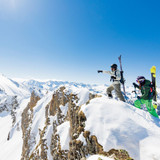What is Backcountry Skiing? Embark on Untamed Terrain
What is Backcountry Skiing?
Backcountry skiing, also known as ski touring or off-piste skiing, is an exhilarating winter sport that takes you far beyond the groomed runs of a traditional ski resort. Imagine leaving the crowds behind and venturing into a vast landscape of untouched powder snow, carving your own path through awe-inspiring mountain terrain. Backcountry skiing offers a deep connection with nature and a sense of adventure unmatched by any other winter activity. This blog serves as your introduction to the world of backcountry skiing. We'll explore the fundamental differences between backcountry and resort skiing, discuss essential gear, delve into crucial safety considerations, and offer some helpful tips for your first forays into the backcountry.
Gear Up for Adventure: Essentials for Backcountry Skiing
Backcountry skiing demands a different set of equipment compared to resort skiing. Here's a breakdown of the key gear elements you'll need:
- Skis and Bindings: Backcountry skis are typically lighter and wider than resort skis, offering better floatation in deep snow. Choose bindings compatible with ski touring boots, allowing for both walking and downhill skiing modes.
- Ski Touring Boots: These boots offer both walking/climbing functionality and downhill skiing performance. Look for boots with a comfortable fit and good ankle mobility for ascents.
- Backcountry Poles: Extendable poles are ideal for stability and skin track creation during uphill travel.
- Avalanche Safety Gear: This is absolutely essential for backcountry skiing. A backpack with an avalanche beacon, probe, and shovel is mandatory to ensure your safety in case of an avalanche.
- Navigation Tools: A map, compass, and GPS device are crucial for route planning and staying oriented in the backcountry. Consider taking an avalanche safety course to learn how to use these tools effectively.
- Warm Clothing: Layering is key for backcountry adventures. Pack breathable base layers, insulating mid-layers, and a waterproof outer shell to stay warm and dry.
- Hydration Pack: Staying hydrated is essential, especially during strenuous uphill climbs. Choose a backpack with a hydration sleeve for convenient access to water.
- Ski Goggles: Protecting your eyes from the sun's glare, wind, and snow is paramount in the backcountry, where weather conditions can change rapidly. Invest in high-quality ski goggles with interchangeable lenses for varying light conditions. Look for features like anti-fog technology and good ventilation to prevent fogging.
A Note on Ski Goggles: For those who require corrective lenses, fret not! Goggles N More offers a fantastic selection of prescription ski goggles. These specially designed goggles seamlessly integrate your prescription with the protective features of regular ski goggles, ensuring optimal vision and eye protection for your backcountry adventures.

Planning Your Backcountry Journey: Safety First!
Backcountry skiing offers immense freedom, but it also comes with inherent risks. Safety is paramount, and proper planning is essential before venturing out. Here are some key considerations:
Prescription Swim Goggles – Sports Goggles – Ski Goggles
LEADER IN PRESCRIPTION GOGGLES AND GLASSES
Kids RX Swim Goggles – Adult RX Swim Goggles – Prescription Sports Goggles - RX Ski Goggles

 Canadian Dollar (CAD)
Canadian Dollar (CAD)
 Euro (EUR)
Euro (EUR)
 British Pound (GBP)
British Pound (GBP)











